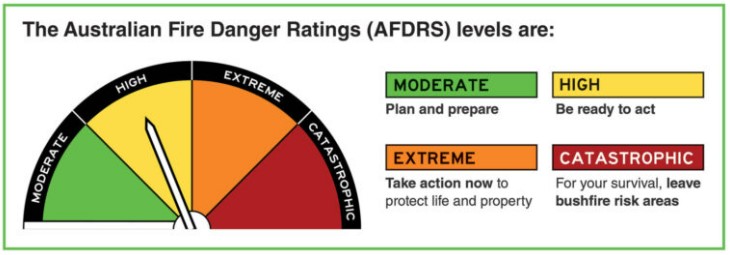Fire season across the country has well and truly started, so if you haven’t already, it’s time to prepare both on-farm and across your broader community.
Following three years of La Nina weather patterns, the recently declared El Nino, backed by a hotter than average August and September, potentially increases bushfire risk.

Bushfire preparedness should be a priority every year, and there’s a number of obvious yet simple things you can do to be ready should a fire event occur at or near your property –
- Know the fire danger ratings;
- Have an up to date fire safety plan – this should include identifying hazards, clearing excess vegetation, having well-maintained fire-fighting equipment, and ensuring easy access to water sources;
- Actively engage with your neighbours and your local RFS – collaborative efforts can include sharing resources, coordinating evacuation plans, and participating in community fire safety initiatives;
- Run regular fire safety drills and training sessions with your employees so that everyone knows what to do in case of a fire emergency.
Being aware that independent travellers like backpackers are often travelling in small groups, couples or even on their own, they may have little knowledge of Australian geography outside of the major cities.
So, if you’re employing backpackers on your farm, or have guests in your hostel who are worried about what they see on TV, the internet or social media, they may look to you for reassurance or advice. Take their concerns seriously, provide them with good advice, and they will be very grateful to you.
Fire Danger Rating System
As of September 2022, Australia has a simplified, national, action-oriented fire danger rating system – it uses four easy to recognise rating levels, each with a message to encourage you to act to protect yourself and others in the face of bushfire risk.
Monitor conditions and official sources for warnings. Adhere to local regulations governing fire activity and ensure any industrial or agricultural activities adhere to relevant industry guidelines.
If a fire starts near you, act immediately to protect your life. Do not wait for a warning.
Fire danger information is usually broadcast on television, radio and printed in newspapers. Or you may see the current fire danger rating level on roadside signs, on social media, in apps or on websites. These are good prompts for you to seek more information from your state or territory’s fire and emergency services portal.
Download the App
Each Australian state have their own emergency services and their own fire-fighting authority. Make sure you know the name of the one in the state you are visiting or residing, find their website and download their app.
As a result of the lessons learned from disasters in the past, particularly fire, these sources of information are now expressly designed to provide highly valuable information that is constantly updated.
Below is the list of websites for fire authorities in each state:
New South Wales: www.rfs.nsw.gov.au
Victoria: www.cfa.vic.gov.au
Tasmania: www.fire.tas.gov.au
Australian Capital Territory: www.esa.act.gov.au
Northern Territory: www.pfes.nt.gov.au
Queensland: www.ruralfire.qld.gov.au
South Australia: www.cfs.sa.org.au
Western Australia: www.emergency.wa.gov.au
It’s also a good idea to familiarise yourself with the Australia Fire Danger Rating System website – www.afdrs.com.au
Stay safe this fire season and do your bit to ensure the safety of others.

